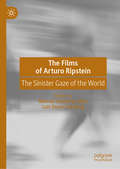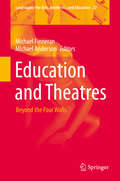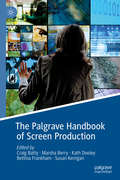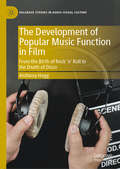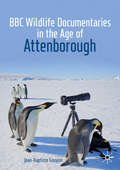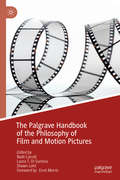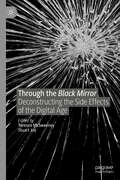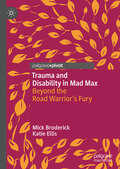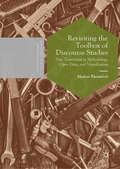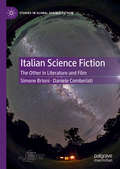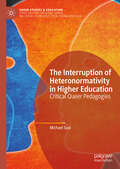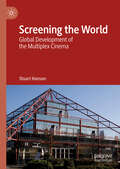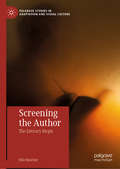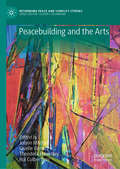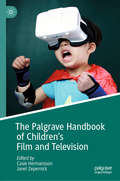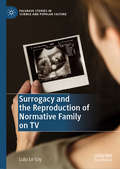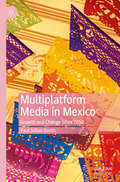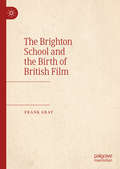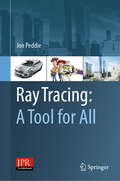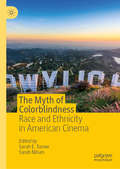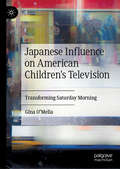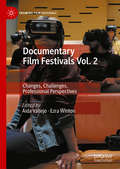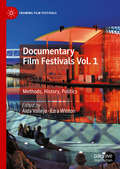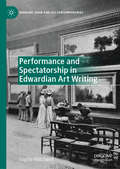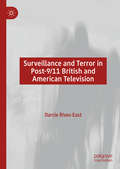- Table View
- List View
The Films of Arturo Ripstein: The Sinister Gaze of the World
by Manuel Gutiérrez Silva Luis Duno GottbergThis book gathers eleven scholarly contributions dedicated to the work of Mexican director Arturo Ripstein. The collection, the first of its kind, constitutes a sustained critical engagement with the twenty-nine films made by this highly acclaimed yet under-studied filmmaker. The eleven essays included come from scholars whose work stands at the intersection of the fields of Latin American and Mexican Film Studies, Gender and Queer Studies, Cultural Studies, History and Literary studies. Ripstein’s films, often scripted by his long-time collaborator, Paz Alicia Garciadiego, represent an unprecedented achievement in Mexican and Latin American film. Unlike many of his contemporaries, Ripstein has successfully maintained a prolific output unmatched by any director in the region. Though several book-length studies have been published in Spanish, French, German, and Greek, to date no analogue exists in English. This volume provides a much-needed contribution to the field.
Education and Theatres: Beyond the Four Walls (Landscapes: the Arts, Aesthetics, and Education #27)
by Michael Anderson Michael FinneranThis volume is the first book to map a broad range of practices and critically examine the impact of education and outreach programmes in theatres and theatre companies around the globe.This innovative volume looks specifically at the manner in which theatres and theatre companies engage in educational, outreach and community work. An array of global case studies examines a wide range of existing and innovative practices, and scrutinises how this work achieves successful results and delivers impact and outcome on investment.The editors set the scene briefly in terms of the history of education in theatre organisations, and then move on to chart some of the difficulties and challenges associated with this work, as well as looking into the conceptual issues that need to be interrogated so that we may understand the impact of outreach and education work on the communities and audiences it aims to reach. A range of theatre practitioners and academics describe their work, its background, and what the authors understand to be successful outcomes for both the participants and the theatres. Finally, the book offers suggestions for both practitioners and researchers regarding further development in this work.
The Palgrave Handbook of Screen Production
by Craig Batty Marsha Berry Susan Kerrigan Kath Dooley Bettina FrankhamThis handbook is an essential creative, critical and practical guide for students and educators of screen production internationally. It covers all aspects of screen production—from conceptualizing ideas and developing them, to realizing and then distributing them—across all forms and formats, including fiction and non-fiction for cinema, television, gallery spaces and the web. With chapters by practitioners, scholars and educators from around the world, the book provides a comprehensive collection of approaches for those studying and teaching the development and production of screen content. With college and university students in mind, the volume purposely combines theory and practice to offer a critically informed and intellectually rich guide to screen production, shaped by the needs of those working in education environments where ‘doing’ and ‘thinking’ must co-exist. The Palgrave Handbook of Screen Production fills an important gap in creative-critical knowledge of screen production, while also providing practical tools and approaches for future practitioners.
The Development of Popular Music Function in Film: From the Birth of Rock ‘n’ Roll to the Death of Disco (Palgrave Studies in Audio-Visual Culture)
by Anthony HoggThis book offers a unique examination of the development of popular music function in film. It assesses the contribution of popular music to the interpretation of the most significant films, covering the period from rock ‘n’ roll’s initial introduction at the opening of Blackboard Jungle, to the backlash against disco, which followed soon after the release of Saturday Night Fever. By dividing this period into five phases—The Classical American Musical Phase, The British Invasion Phase, The New Hollywood Alienation Phase, The Disco Phase and The Post-Disco Conservative Phase—the book pinpoints key moments at which individual developments occurred and lays out a path of expansion in popular music function. Each chapter offers close analyses of this period’s most innovative films; examines the cultural, historical, technical and industrial factors peculiar to each phase and considers the influence of these upon the specific timing of functional advances.
BBC Wildlife Documentaries in the Age of Attenborough (Palgrave Studies in Science and Popular Culture)
by Jean-Baptiste GouyonThis book explores the history of wildlife television in post-war Britain. It revolves around the role of David Attenborough, whose career as a broadcaster and natural history filmmaker has shaped British wildlife television. The book discusses aspects of Attenborough’s professional biography and also explores elements of the institutional history of the BBC—from the early 1960s, when it was at its most powerful, to the 2000s, when its future is uncertain. It focuses primarily on the wildlife ‘making-of’ documentary genre, which is used to trace how television progressively became a participant in the production of knowledge about nature. With the inclusion of analysis of television programmes, first-hand accounts, BBC archival material and, most notably, interviews with David Attenborough, this volume follows the development of the professional culture of wildlife broadcasting as it has been portrayed in public. It will be of interest to wildlife television amateurs, historians of British television and students in science communication.
The Palgrave Handbook of the Philosophy of Film and Motion Pictures
by Noël Carroll Laura T. Di Summa Shawn LohtThis handbook brings together essays in the philosophy of film and motion pictures from authorities across the spectrum. It boasts contributions from philosophers and film theorists alike, with many essays employing pluralist approaches to this interdisciplinary subject. Core areas treated include film ontology, film structure, psychology, authorship, narrative, and viewer emotion. Emerging areas of interest, including virtual reality, video games, and nonfictional and autobiographical film also have dedicated chapters. Other areas of focus include the film medium’s intersection with contemporary social issues, film’s kinship to other art forms, and the influence of historically seminal schools of thought in the philosophy of film. Of emphasis in many of the essays is the relationship and overlap of analytic and continental perspectives in this subject.
Through the Black Mirror: Deconstructing the Side Effects of the Digital Age
by Terence McSweeney Stuart JoyThis edited collection charts the first four seasons of Black Mirror and beyond, providing a rich social, historical and political context for the show. Across the diverse tapestry of its episodes, Black Mirror has both dramatized and deconstructed the shifting cultural and technological coordinates of the era like no other. With each of the nineteen chapters focussing on a single episode of the series, this book provides an in-depth analysis into how the show interrogates our contemporary desires and anxieties, while simultaneously encouraging audiences to contemplate the moral issues raised by each episode. What if we could record and replay our most intimate memories? How far should we go to protect our children? Would we choose to live forever? What does it mean to be human? These are just some of the questions posed by Black Mirror, and in turn, by this volume. Written by some of the foremost scholars in the field of contemporary film and television studies, Through the Black Mirror explores how Black Mirror has become a cultural barometer of the new millennial decades and questions what its embedded anxieties might tell us.
Trauma and Disability in Mad Max: Beyond the Road Warrior’s Fury
by Mick Broderick Katie EllisThis book explores the inter-relationship of disability and trauma in the Mad Max films (1979-2015). George Miller’s long-running series is replete with narratives and imagery of trauma, both physical and emotional, along with major and minor characters who are prominently disabled. The Mad Max movies foreground representations of the body – in devastating injury and its lasting effects – and in the broader social and historical contexts of trauma, disability, gender and myth.Over the franchise’s four-decade span significant social and cultural change has occurred globally. Many of the images of disability and trauma central to Max’s post-apocalyptic wasteland can be seen to represent these societal shifts, incorporating both decline and rejuvenation. These shifts include concerns with social, economic and political disintegration under late capitalism, projections of survival after nuclear war, and the impact of anthropogenic climate change.Drawing on screen production processes, textual analysis and reception studies this book interrogates the role of these representations of disability, trauma, gender and myth to offer an in-depth cultural analysis of the social critiques evident within the fantasies of Mad Max.
Revisiting the Toolbox of Discourse Studies: New Trajectories in Methodology, Open Data, and Visualization (Postdisciplinary Studies in Discourse)
by Markus RheindorfThis book revisits discourse analytic practice, analyzing the idea that the field has access to, provides, or even constitutes a ‘toolbox’ of methods. The precise characteristics of this toolbox have remained largely un-theorized, and the author discusses the different sets of tools and their combinations, particularly those that cut across traditional divides, such as those between disciplines or between quantitative and qualitative methods. The author emphasizes the potential value of integrating methods in terms of triangulation and its specific benefits, arguing that current trends in Open Science require Discourse Studies to re-examine its methodological scope and choices, and move beyond token acknowledgements of ‘eclecticism’. In-depth case studies supplement the methodological discussion and demonstrate the challenges and benefits of triangulation. This book will be a valuable resource for students and scholars in Discourse Studies, particularly those with an interest in combining methods and working across disciplines.
Italian Science Fiction: The Other in Literature and Film (Studies in Global Science Fiction)
by Simone Brioni Daniele ComberiatiThis book explores Italian science fiction from 1861, the year of Italy’s unification, to the present day, focusing on how this genre helped shape notions of Otherness and Normalness. In particular, Italian Science Fiction draws upon critical race studies, postcolonial theory, and feminist studies to explore how migration, colonialism, multiculturalism, and racism have been represented in genre film and literature. Topics include the role of science fiction in constructing a national identity; the representation and self-representation of “alien” immigrants in Italy; the creation of internal “Others,” such as southerners and Roma; the intersections of gender and race discrimination; and Italian science fiction’s transnational dialogue with foreign science fiction. This book reveals that though it is arguably a minor genre in Italy, science fiction offers an innovative interpretive angle for rethinking Italian history and imagining future change in Italian society.
The Interruption of Heteronormativity in Higher Education: Critical Queer Pedagogies (Queer Studies and Education)
by Michael SealThis book examines how heteronormativity in higher education can be interrupted and resisted. Located within the theoretical framework of queer and critical pedagogy and based on extensive empirical research, the author explores the dynamics of heteronormativity and its interruption on professional courses in a range of higher education institutions. Reactions to attempt to interrupt it were nuanced: while strategies of contested engagement, avoidance and retreat were expressed, heterosexualities were largely un-examined and un-articulated. ‘Coming out’ needs to be a pedagogical act, carried out concurrently with the interruptions of other social constructions and binary oppositions. The author calls for co-created and co-held meta-reflexive and liminal spaces that emphasise inter-subjectivity, encounters, and working in the moment. These spaces must de-construct and reconstruct pedagogical power and knowledge to promote collective intersubjective consciousnesses, and widen the vision of the reflective practitioner to that of the pedagogical practitioner. This pioneering book is a call to action to all those concerned with interrupting and problematising presumed binary categories of sexuality within the heterosexual matrix.
Screening the World: Global Development of the Multiplex Cinema
by Stuart HansonThis book charts the development of the multiplex cinema as the pre-eminent form of film exhibition across the world. Going from its origins in the USA in the 1960s to its expansion overseas from the mid-1980s across Europe, Australia and other parts of Asia-Pacific, the book considers the emergence of a series of initially regional, then national and then international exhibition circuits. However, more than a consideration of US overseas expansion on the part of companies, this book examines the hegemony of the multiplex as a cultural and business form, arguing for its significance as a phenomenon that has transcended national and global boundaries and which has become the predominant venue for film viewing. Implicit in this analysis is a recognition of the domination of US media multi-nationals and Hollywood cinema, and the development of the multiplex cinema as symbolic of the extension and maintenance of the USA’s cultural and economic power. With case studies ranging from European countries such as Belgium, France, Germany and The Netherlands, to Pacific-Asian countries such as Australia, China, Japan and South Korea, this book is the first to explore the development of multiplexes on a global scale.
Screening the Author: The Literary Biopic (Palgrave Studies in Adaptation and Visual Culture)
by Hila ShacharThis book is the first comprehensive analysis of the contemporary representation of the author on screen. It does this through two main approaches: by looking at how biographies of well-known authors in Western culture have been adapted onto the film and television screen; and by examining the wider preoccupation with the idea of what the ‘author persona’ means in broader economic, cultural, industrial, and ideological terms. Drawing from current debates about the uses of the heritage industry and conventions of the Hollywood biopic and celebrity culture, this book re-frames the analysis of the author on screen in contemporary culture and theorises it under its own unique genre: the ‘literary biopic’. With case studies including adaptations of the biographies and cultural personas of William Shakespeare, Jane Austen, Oscar Wilde, Sylvia Plath, Virginia Woolf, and Allen Ginsberg—to name a few–this book examines how and why the author continues to be a prominent screen and cultural preoccupation.
Peacebuilding and the Arts (Rethinking Peace and Conflict Studies)
by Jolyon Mitchell Giselle Vincett Theodora Hawksley Hal Culbertson"Ending violent conflict requires societies to take leaps of political imagination. Artistic communities are often uniquely placed to help promote new thinking by enabling people to see things differently. In place of conflict’s binary divisions, artists are often charged with exploring the ambiguities and possibilities of the excluded middle. Yet, their role in peacebuilding remains little explored. This excellent and agenda-setting volume provides a ground-breaking look at a range of artistic practices, and the ways in which they have attempted to support peacebuilding – a must-read for all practitioners and policy-makers, and indeed other peacemakers looking for inspiration."Professor Christine Bell, FBA, Professor of Constitutional Law, Assistant Principal (Global Justice), and co-director of the Global Justice Academy, The University of Edinburgh, UK"Peacebuilding and the Arts offers an impressive and impressively comprehensive engagement with the role that visual art, music, literature, film and theatre play in building peaceful and just societies. Without idealizing the role of the arts, the authors explore their potential and limits in a wide range of cases, from Korea, Cambodia, Colombia and Northern Ireland to Uganda, Rwanda, South Africa and Israel-Palestine."Roland Bleiker, Professor of International Relations, University of Queensland, Australia, and author of Aesthetics and World Politics and Visual Global Politics"Peacebuilding and the Arts is the first publication to focus critically and comprehensively on the relations between the creative arts and peacebuilding, expanding the conventional boundaries of peacebuilding and conflict transformation to include the artist, actor, poet, novelist, dramatist, musician, dancer and film director. The sections on the visual arts, music, literature, film and theatre, include case studies from very different cultures, contexts and settings but a central theme is that the creative arts can play a unique and crucial role in the building of peaceful and just societies, with the power to transform relationships, heal wounds, and nurture compassion and empathy. Peacebuilding and the Arts is a vital and unique resource which will stimulate critical discussion and further research, but it will also help to refine and reframe our understanding of peacebuilding. While it will undoubtedly become mandatory reading for students of peacebuilding and the arts, its original approach and dynamic exploratory style should attract a much wider interdisciplinary audience."Professor Anna King, Professor of Religious Studies and Social Anthropology and Director of Research, Centre of Religion, Reconciliation and Peace (WCRRP), University of Winchester, UKThis volume explores the relationship between peacebuilding and the arts. Through a series of original essays, authors consider some of the ways that different art forms (including film, theatre, music, literature, dance, and other forms of visual art) can contribute to the processes and practices of building peace. This book breaks new ground, by setting out fresh ways of analysing the relationship between peacebuilding and the arts. Divided into five sections on the Visual Arts, Music, Literature, Film and Theatre/Dance, over 20 authors offer conceptual overviews of each art form as well as new case studies from around the globe and critical reflections on how the arts can contribute to peacebuilding. As interest in the topic increases, no other book approaches this complex relationship in the way that Peacebuilding and the Arts does. By bringing together the insights of scholars and practitioners working at the intersection of the arts and peacebuilding, this book develops a series of unique, critical perspectives on the interaction of diverse art forms with a range of peacebuilding endeavours.
The Palgrave Handbook of Children's Film and Television
by Casie Hermansson Janet ZepernickThis volume explores film and television for children and youth. While children’s film and television vary in form and content from country to country, their youth audience, ranging from infants to “screenagers”, is the defining feature of the genre and is written into the DNA of the medium itself. This collection offers a contemporary analysis of film and television designed for this important audience, with particular attention to new directions evident in the late twentieth and early twenty-first centuries. With examples drawn from Iran, China, Korea, India, Israel, Eastern Europe, the Philippines, and France, as well as from the United States and the United Kingdom, contributors address a variety of issues ranging from content to production, distribution, marketing, and the use of film, both as object and medium, in education. Through a diverse consideration of media for young infants up to young adults, this volume reveals the newest trends in children’s film and television and its role as both a source of entertainment and pedagogy.
Surrogacy and the Reproduction of Normative Family on TV (Palgrave Studies in Science and Popular Culture)
by Lulu Le VayThis book examines the proliferation of surrogacy storylines on TV, exploring themes of infertility, motherhood, parenting and family. It investigates how, despite reproductive technologies’ ability to flex contours of family, the shows’ narratives work to uphold the white, heterosexual, genetically-reproduced family as the ideal. In dialogue with responses from a range of female viewers, both mothers and non-mothers, the book scrutinises the construction of family ideology on television with studies including Coronation Street (1960-present), Giuliana & Bill (2009-2014), Rules of Engagement (2007-2013), The New Normal (2012-2013), Top of the Lake: China Girl (2017) The Handmaid’s Tale (2017-present) and film Baby Mama (2008). These studies raise a number of questions; is homosexuality only acceptable when it echoes heterosexual norms? Are female characters only fulfilled when they are genetic mothers? Does heterosexual romance override technology in the cure for infertility? While the answers to these questions may suggest that television still conforms to heteronormative narratives, this book importantly demonstrates that audiences desire alternative happy endings that show infertile female characters more positively and recognise alternative kinship formations as meaningful.
Multiplatform Media in Mexico: Growth and Change Since 2010
by Paul Julian SmithMultiplatform Media in Mexico is the first book to treat the exciting, interconnected fields of cinema, television, and internet in Mexico over the last decade, fields that combine to be called multiplatform media. Combining industrial analysis of a major audiovisual field at a time of growth and change with close readings of significant texts on all screens, acclaimed author Paul Julian Smith deftly details these new audiovisual trends. The book includes perspectives on local reporting on the ground, as covered in the chapter documenting media response to the 2017 earthquake. And, for the first time in this field, the book draws throughout on star studies, tracing the distinct profiles of actors who migrate from one medium to another. As a whole, Smith’s analyses illustrate the key movements in screen media in one of the world’s largest media and cultural producing nations. These perspectives connect to and enrich scholarship across Latin American, North American, and global cases.
The Brighton School and the Birth of British Film
by Frank GrayThis study is devoted to the work of two early British filmmakers, George Albert Smith and James Williamson, and the films that they made around 1900. Internationally, they are known collectively as the ‘Brighton School’ and are positioned as being at the forefront of Britain’s contribution to the birth of film. The book focuses on the years 1896 to 1903, as it was during this short period that film emerged as a new technology, a new enterprise and a new form of entertainment. Beginning with a historiography of the Brighton School, the study goes on to examine the arrival of the first 35mm films in Britain, the first film exhibitions in Brighton and the first projection of film in Brighton. Both Smith and Williamson’s work features a progression from the production of single shot unedited films to multi-shot edited films. Their subject matter was inspired by a knowledge of contemporary pantomime, humour, literature, theatre, mesmerism, the magic lantern and current affairs and their practices were underpinned by active involvement in the new film trade. Through the exploration of how these filmmakers cultivated a new way of understanding film and its commercial potential, this book establishes them as key figures in the development of British film culture.
Ray Tracing: A Tool for All
by Jon PeddieThis is the first book to offer a comprehensive overview for anyone wanting to understand the benefits and opportunities of ray tracing, as well as some of the challenges, without having to learn how to program or be an optics scientist.It demystifies ray tracing and brings forward the need and benefit of using ray tracing throughout the development of a film, product, or building — from pitch to prototype to marketing.Ray Tracing and Rendering clarifies the difference between conventional faked rendering and physically correct, photo-realistic ray traced rendering, and explains how programmer’s time, and backend compositing time are saved while producing more accurate representations with 3D models that move.Often considered an esoteric subject the author takes ray tracing out of the confines of the programmer’s lair and shows how all levels of users from concept to construction and sales can benefit without being forced to be a practitioner. It treats both theoretical and practical aspects of the subject as well as giving insights into all the major ray tracing programs and how many of them came about.It will enrich the readers’ understanding of what a difference an accurate high-fidelity image can make to the viewer — our eyes are incredibly sensitive to flaws and distortions and we quickly disregard things that look phony or unreal. Such dismissal by a potential user or customer can spell disaster for a supplier, producer, or developer. If it looks real it will sell, even if it is a fantasy animation. Ray tracing is now within reach of every producer and marketeer, and at prices one can afford, and with production times that meet the demands of today’s fast world.
The Myth of Colorblindness: Race and Ethnicity in American Cinema
by Sarah E. Turner Sarah NilsenThis book explores representations of race and ethnicity in contemporary cinema and the ways in which these depictions all too often promulgate an important racial ideology: the myth of colorblindness. Colorblindness is a discursive framework employed by mainstream, neoliberal media to celebrate a multicultural society while simultaneously disregarding its systemic and institutionalized racism. This collection is unique in its examination of such films as Ex Machina, The Lone Ranger, The Blind Side, Zootopia, The Fast and the Furious franchise, and Dope, which celebrate the myth of colorblindness, yet perpetuate and entrench the racism and racial inequities that persist in contemporary society. While the #OscarsSoWhite movement has been essential to bringing about structural changes to media industries and offers the opportunity for a wide diversity of voices to alter and transform the dominant, colorblind narratives continue to proliferate. As this book demonstrates, Hollywood still has a long way to go.
Japanese Influence on American Children's Television: Transforming Saturday Morning
by Gina O’MeliaJapanese Influence on American Children’s Television examines the gradual, yet dramatic, transformation of Saturday morning children’s programming from being rooted in American traditions and popular culture to reflecting Japanese popular culture. In this modern era of globalization and global media/cultural convergence, the book brings to light an often overlooked phenomenon of the gradual integration of narrative and character conventions borrowed from Japanese storytelling into American children’s media. The book begins with a brief history of Saturday morning in the United States from its earliest years, and the interaction between American and Japanese popular media during this time period. It then moves onto reviewing the dramatic shift that occurred within the Saturday morning block through both an overview of the transitional decades as well as an in-depth analysis of the transformative ascent of the shows Mighty Morphin Power Rangers, Pokémon, and Yu-Gi-Oh!.
Documentary Film Festivals Vol. 2: Changes, Challenges, Professional Perspectives (Framing Film Festivals)
by Aida Vallejo Ezra WintonThis book provides the first comprehensive overview of the global landscape of documentary film festivals, looking at its contemporary and future challenges. Contributors from across the globe reflect on how documentary has positioned itself within both internationally renowned and more alternative festivals, including IDFA (Netherlands), Cannes IFF (France), Sheffield Doc/Fest (UK), Dockanema (Mozambique), Ismailia (Egypt) and Zinebi (Basque Country, Spain), among others. With a special focus on industrial and curatorial developments, this second in a two-volume set looks at recent changes occurred in the festival circuit, such as the proliferation of markets and co-production forums, the inclusion of interactive and VR forms within their programs and the irruption of VOD platforms, and analyse how these affect the future of documentary aesthetics and its production/distribution contexts.This volume is organized in two sections: the first reflects on how the documentary festival circuit has become a key industry node for contemporary documentary and identifies new curatorial trends at documentary and major film festivals. The second gives voice to professionals working for festivals and institutions who collaborate with them, who share inside knowledge and concerns, regarding the future challenges to be faced by documentary in the near future.
Documentary Film Festivals Vol. 1: Methods, History, Politics (Framing Film Festivals)
by Aida Vallejo Ezra WintonThis book provides the first comprehensive overview of the global landscape of documentary film festivals. Contributors from across the globe offer in-depth analysis of both internationally renowned and more alternative festivals, including Hot Docs (Canada), Nyon (Switcherland), Yamagata (Japan), DocChina, Full Frame (US), Belgrade (former Yugoslavia), Vikalp (India), and DocsBarcelona (Catalonia, Spain), among others. With a special focus on historical and political developments, this first volume draws a map of documentary festivals operating today, and then looks at their origins and evolution. This volume is organized in three sections: the first addresses methodological problems film historians and social scientists face when researching documentary film festivals, the second looks at the historical development of this circuit within the wider frame of history of world and national cinemas, and the third reflects on how politics find their way through festival programs and actions. Curatorial, organizational, industrial and political changes occurred in the festival realm addressed in this book help better understand how these affected documentary production, distribution, curation, exhibition and reception up to this day.
Performance and Spectatorship in Edwardian Art Writing (Bernard Shaw and His Contemporaries)
by Sophie HatchwellThis book explores how Edwardian art writing shaped and narrated embodied, performative forms of aesthetic spectatorship. It argues that we need to expand the range of texts we think of as art writing, and features a diverse array of critical and fictional works, often including texts that are otherwise absent from art-historical study. Multi-disciplinary in scope, this book proposes a methodology for analyzing the aesthetic encounter within and through art writing, adapting and reworking a form of phenomenological-semiotic analysis found conventionally in performance studies. It focuses on moments where theories of spectatorship meet practice, moving between the varied spaces of Edwardian art viewing, from the critical text, to the lecture hall, the West End theatre and gallery, middle-class home, and fictional novel. It contributes to a rethinking of Edwardian culture by exploring the intriguing heterogeneity and self-consciousness of viewing practices in a period more commonly associated with the emergence of formalism.
Surveillance and Terror in Post-9/11 British and American Television
by Darcie Rives-EastThis interdisciplinary study examines how state surveillance has preoccupied British and American television series in the twenty years since 9/11. Surveillance and Terror in Post-9/11 British and American Television illuminates how the U.S. and U.K., bound by an historical, cultural, and television partnership, have broadcast numerous programs centred on three state surveillance apparatuses tasked with protecting us from terrorism and criminal activity: the prison, the police, and the national intelligence agency. Drawing from a range of case studies, such as Sherlock, Orange is the New Black and The Night Manager, this book discusses how television allows viewers, writers, and producers to articulate fears about an increased erosion of privacy and civil liberties following 9/11, while simultaneously expressing a desire for a preventative mechanism that can stop such events occurring in the future. However, these concerns and desires are not new; encompassing surveillance narratives both past and present, this book demonstrates how television today builds on earlier narratives about panoptic power to construct our present understanding of government surveillance.
